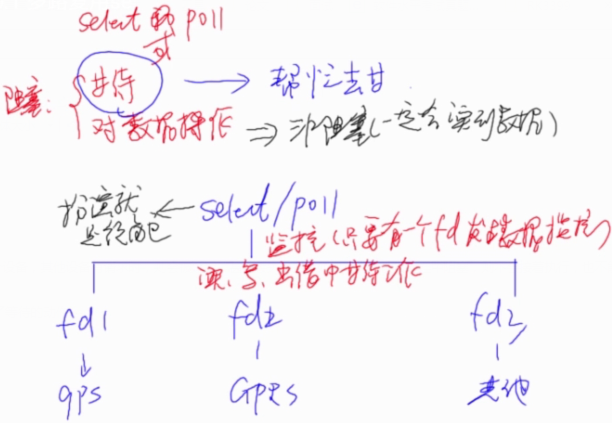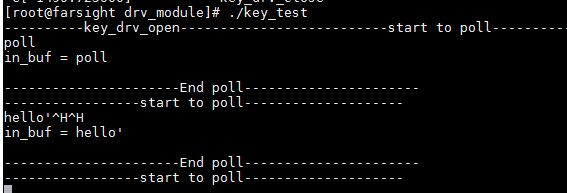多路复用
1、概念
假设:在单进程与单线程情况下,应用程序要同时处理多路IO流(多个设备)
如果在应用程序中采用while(1) { read() ... }进行处理,那么每次只能处理一个设备,其他设备有请求时,则会被延迟,甚至丢失数据。如果在一个设备处理中阻塞,则不会接着执行,也不能处理其他设备的数据。因此,可以采用多路复用的方法:select 、 poll
阻塞模式下会有两种情况:等待 、对数据进行操作。多路复用就是实现了等待的动作。

2、多路复用的思想
—先构造一张有关描述符的表,然后调用一个函数(select/poll)。当这些文件描述符中的一个或多个已经准备好进行IO时,函数才返回。
—函数返回时,告诉进程那个描述符已经就绪,可以进行IO操作。
3、实现步骤
- 把关心的文件描述符加入到fd_set集合中
- 调用select / poll函数去监控集合fd_set中的文件描述符(阻塞等待集合中一个或多个文件描述符有数据)
- 当有数据时,退出select()阻塞
- 依次判断哪个文件描述符有数据
- 依次处理有数据的文件描述符的数据
4、poll的应用
1, 需要打开多个文件(多个设备) 2, 利用poll来实现监控fd的读,写,出错 #include <poll.h> int poll(struct pollfd *fds, nfds_t nfds, int timeout); 参数1: 表示多个文件描述符集合 struct pollfd描述的是文件描述符的信息 struct pollfd { int fd; //文件描述符 short events; //希望监控fd的什么事件:读,写,出错 POLLIN 读, POLLOUT 写, POLLERR出错 short revents; //结果描述,表示当前的fd是否有读,写,出错 //用于判断,是内核自动赋值 POLLIN 读, POLLOUT 写, POLLERR出错 }; 参数2:被监控的fd的个数 参数3: 监控的时间: 正: 表示监控多少ms 负数: 无限的时间去监控 0: 等待0ms,类似于非阻赛 返回值: 负数:出错 大于0,表示fd中有数据 等于0: 时间到
5、在驱动代码中实现poll接口
如果应用中使用poll对设备文件进行了监控,那么设备驱动就必须实现poll接口
unsigned int key_drv_poll(struct file *filp, struct poll_table_struct *pts) { // 返回一个mask值 unsigned int mask; // 调用poll_wait,将当前到等待队列注册系统中 poll_wait(filp, &key_dev->wq_head, pts); // 1,当没有数据到时候返回一个0 if(!key_dev->key_state) mask = 0; // 2,有数据返回一个POLLIN if(key_dev->key_state) mask |= POLLIN;
return mask; } const struct file_operations key_fops = { .poll = key_drv_poll, };
6、示例--多路复用poll实现

1 #include <linux/init.h> 2 #include <linux/module.h> 3 #include <linux/of.h> 4 #include <linux/of_irq.h> 5 #include <linux/interrupt.h> 6 #include <linux/slab.h> 7 #include <linux/fs.h> 8 #include <linux/device.h> 9 #include <linux/kdev_t.h> 10 #include <linux/err.h> 11 #include <linux/device.h> 12 #include <asm/io.h> 13 #include <asm/uaccess.h> 14 #include <linux/wait.h> 15 #include <linux/sched.h> 16 #include <linux/poll.h> 17 18 19 #define GPXCON_REG 0X11000C20 //不可以从数据寄存器开始映射,要配置寄存器 20 #define KEY_ENTER 28 21 22 //0、设计一个描述按键的数据的对象 23 struct key_event{ 24 int code; //按键类型:home,esc,enter 25 int value; //表状态,按下,松开 26 }; 27 28 //1、设计一个全局对象——— 描述key的信息 29 struct key_desc{ 30 unsigned int dev_major; 31 int irqno; //中断号 32 struct class *cls; 33 struct device *dev; 34 void *reg_base; 35 struct key_event event; 36 wait_queue_head_t wq_head; 37 int key_state; //表示是否有数据 38 }; 39 40 struct key_desc *key_dev; 41 42 43 irqreturn_t key_irq_handler(int irqno, void *devid) 44 { 45 printk("----------%s---------",__FUNCTION__); 46 47 int value; 48 //读取按键状态 49 value = readl(key_dev->reg_base + 4) & (0x01<<2); 50 51 if(value){ 52 printk("key3 up "); 53 key_dev->event.code = KEY_ENTER; 54 key_dev->event.value = 0; 55 }else{ 56 printk("key3 down "); 57 key_dev->event.code = KEY_ENTER; 58 key_dev->event.value = 1; 59 } 60 61 //表示有数据,唤醒等待队列中的等待项 62 wake_up_interruptible(&key_dev->wq_head); 63 64 //同时设置标志位,表示有数据 65 key_dev->key_state = 1; 66 67 return IRQ_HANDLED; 68 } 69 70 71 //获取中断号 72 int get_irqno_from_node(void) 73 { 74 int irqno; 75 //获取设备树中的节点 76 struct device_node *np = of_find_node_by_path("/key_int_node"); 77 if(np){ 78 printk("find node success "); 79 }else{ 80 printk("find node failed "); 81 } 82 83 //通过节点去获取中断号 84 irqno = irq_of_parse_and_map(np, 0); 85 printk("iqrno = %d",key_dev->irqno); 86 87 return irqno; 88 } 89 90 ssize_t key_drv_read (struct file * filp, char __user * buf, size_t count, loff_t * fops) 91 { 92 //printk("----------%s---------",__FUNCTION__); 93 int ret; 94 95 //在没有数据时,进行休眠 96 //key_state在zalloc初始化空间后,为0,则阻塞 97 wait_event_interruptible(key_dev->wq_head, key_dev->key_state); 98 99 ret = copy_to_user(buf, &key_dev->event, count); 100 if(ret > 0) 101 { 102 printk("copy_to_user error "); 103 return -EFAULT; 104 } 105 106 107 //传递给用户数据后,将数据清除,否则APP每次读都是第一次的数据 108 memset(&key_dev->event, 0, sizeof(key_dev->event)); 109 key_dev->key_state = 0; 110 111 return count; 112 } 113 114 ssize_t key_drv_write (struct file *filp, const char __user * buf, size_t count, loff_t * fops) 115 { 116 printk("----------%s---------",__FUNCTION__); 117 return 0; 118 } 119 120 int key_drv_open (struct inode * inode, struct file *filp) 121 { 122 printk("----------%s---------",__FUNCTION__); 123 return 0; 124 } 125 126 int key_drv_close (struct inode *inode, struct file *filp) 127 { 128 printk("----------%s---------",__FUNCTION__); 129 return 0; 130 } 131 132 unsigned int key_drv_poll (struct file * filp, struct poll_table_struct *pts) 133 { 134 //返回一个mask值 135 unsigned int mask = 0; 136 137 //调用poll_wait,将当前的等待队列注册到系统中 138 poll_wait(filp, &key_dev->wq_head, pts); 139 //1、当没有数据的时候返回0 140 if(!key_dev->key_state) 141 { 142 mask = 0; 143 } 144 //2、当有数据的时候返回POLLIN 145 if(key_dev->key_state) 146 mask |= POLLIN; 147 148 return mask; 149 } 150 151 152 const struct file_operations key_fops = { 153 .open = key_drv_open, 154 .read = key_drv_read, 155 .write = key_drv_write, 156 .release = key_drv_close, 157 .poll = key_drv_poll, 158 159 }; 160 161 162 163 static int __init key_drv_init(void) 164 { 165 //演示如何获取到中断号 166 int ret; 167 168 //1、设定全局设备对象并分配空间 169 key_dev = kzalloc(sizeof(struct key_desc), GFP_KERNEL); //GFP_KERNEL表正常分配内存 170 //kzalloc相比于kmalloc,不仅分配连续空间,还会将内存初始化清零 171 172 //2、动态申请设备号 173 key_dev->dev_major = register_chrdev(0, "key_drv", &key_fops); 174 175 //3、创建设备节点文件 176 key_dev->cls = class_create(THIS_MODULE, "key_cls"); 177 key_dev->dev = device_create(key_dev->cls, NULL, MKDEV(key_dev->dev_major, 0), NULL, "key0"); 178 179 //4、硬件初始化 -- 地址映射或中断申请 180 181 key_dev->reg_base = ioremap(GPXCON_REG,8); 182 183 key_dev->irqno = get_irqno_from_node(); 184 185 ret = request_irq(key_dev->irqno, key_irq_handler, IRQF_TRIGGER_FALLING | IRQF_TRIGGER_RISING, 186 "key3_eint10", NULL); 187 if(ret != 0) 188 { 189 printk("request_irq error "); 190 return ret; 191 } 192 193 //初始化等待队列头 194 init_waitqueue_head(&key_dev->wq_head); //wait_queue_head_t *q 195 196 197 198 return 0; 199 } 200 201 static void __exit key_drv_exit(void) 202 { 203 iounmap(GPXCON_REG); 204 free_irq(key_dev->irqno, NULL); //free_irq与request_irq的最后一个参数一致 205 device_destroy(key_dev->cls, MKDEV(key_dev->dev_major, 0)); 206 class_destroy(key_dev->cls); 207 unregister_chrdev(key_dev->dev_major, "key_drv"); 208 kfree(key_dev); 209 } 210 211 212 module_init(key_drv_init); 213 module_exit(key_drv_exit); 214 215 MODULE_LICENSE("GPL");

1 #include <stdio.h> 2 #include <string.h> 3 #include <stdlib.h> 4 #include <unistd.h> 5 #include <sys/types.h> 6 #include <sys/stat.h> 7 #include <fcntl.h> 8 #include <poll.h> 9 10 11 #define KEY_ENTER 28 12 13 //0、设计一个描述按键的数据的对象 14 struct key_event{ 15 int code; //按键类型:home,esc,enter 16 int value; //表状态,按下,松开 17 }; 18 19 20 int main(int argc, char *argv[]) 21 { 22 struct key_event event; 23 int ret; 24 char in_buf[128]; 25 26 int fd; 27 fd = open("/dev/key0", O_RDWR); 28 if(fd < 0) 29 { 30 perror("open"); 31 exit(1); 32 } 33 34 //监控多个文件fd 35 struct pollfd pfd[2]; 36 pfd[0].fd = fd; //监控按键输入 37 pfd[0].events = POLLIN; 38 39 pfd[1].fd = 0; //标准输入:0,标准输出:1,标准出错:2 40 pfd[1].events = POLLIN; 41 42 while(1) 43 { 44 printf("-----------------start to poll-------------------- "); 45 ret = poll(pfd, 2, -1); //在驱动中fops要实现poll接口 46 47 if(ret > 0) 48 { 49 //表示2个fd中至少一个发生读事件 50 if(pfd[0].revents & POLLIN) //revents用于判断,会由内核自动填充 51 { 52 read(pfd[0].fd, &event, sizeof(struct key_event)); //每次读必有数据 53 if(event.code == KEY_ENTER) 54 { 55 if(event.value) 56 { 57 printf("APP__ key enter down "); 58 }else{ 59 60 printf("APP__ key enter up "); 61 } 62 } 63 } 64 65 if(pfd[1].revents & POLLIN) 66 { 67 fgets(in_buf, 128, stdin); //从标准输入中获取128字节存入in_buf 68 printf("in_buf = %s ",in_buf); 69 } 70 } 71 else{ 72 perror("poll"); 73 exit(1); 74 } 75 printf("----------------------End poll---------------------- "); 76 } 77 78 79 close(pfd[0].fd); 80 81 return 0; 82 }

